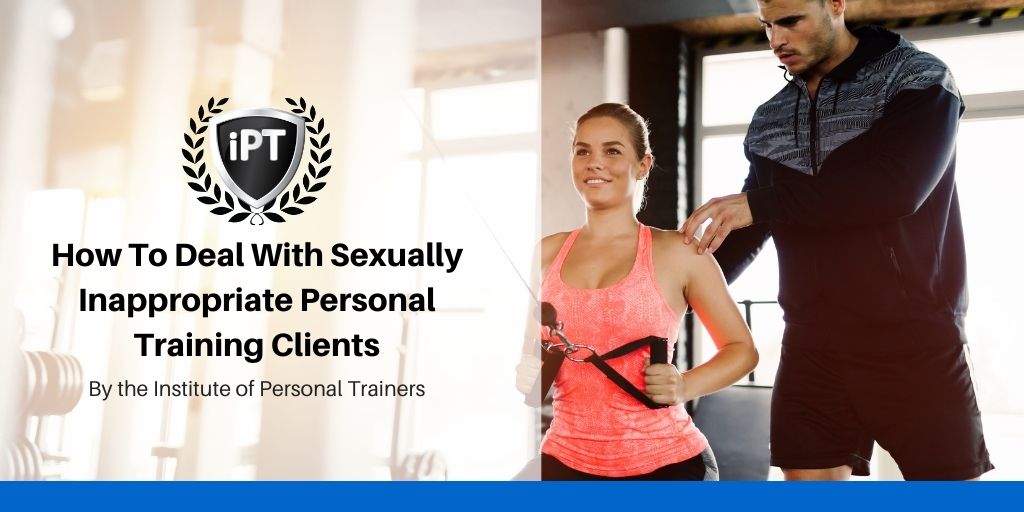|
FREE GUIDE: HOW TO LAUNCH AN ONLINE PERSONAL TRAINING BUSINESS
IN JUST 7 DAYS
✓ The new, better way of launching an online business
✓ The fastest way to create in irresistible offer ✓ A simple system to sell to clients who are interested |
|
In some ways, personal training can be a strange profession. There may be times where you are alone with clients very early in the morning or very late at night when the gym you work in is otherwise empty. Sometimes, while instructing, there may be a tactile cue required, where you - always with consent - will physically touch your client to help them to connect with safe movement patterns. As a professional, it’s important that you and your clients feel safe, and that you are able to maintain boundaries. Sexually inappropriate behaviour includes any behaviour of a sexual nature which creates “an offensive working environment”. The actual definition is extensive and has many examples. Both male and female trainers might be the recipient of inappropriate comments or behaviour. What Is Sexual Harassment?The definition of sexual harassment can vary from country to country, so checking the exact behaviours for your country will be important. However, it may include:
Some of these behaviours are quite explicit and are unlikely to cause confusion. There are some behaviours here that could be misinterpreted, especially in a gym environment. There are a huge range of behaviours which could be included here, but the important thing is how the behaviour makes you feel. If it’s unwanted, offensive, and makes you feel uncomfortable, intimidated, humiliated or scared - then it’s a problem. Everyone has a right to feel safe and comfortable while at work. What To Do If Your Personal Training Clients Are Sexually InappropriateFirstly, if something feels weird to you, trust your gut. If your instincts are telling you that something is off about a client’s behaviour or comments, listen. Those warning feelings are honed over millions of years of evolution; honour them. Document The Incident Thoroughly document that incident. Depending on what happened, making a written account of the details of the exchange might seem unnecessary, even over the top. But do it immediately and as thoroughly as possible. In the event that there ever needs to be a formal complaint made, this will avoid having to rely on memory or “he said, she said” hearsay. You might want to record:
Involve a Manager Work with a manager, if you have one. In most commercial gym facilities, there will be a manager that you should speak to about events like this. Sometimes they will help you to fill out an incident report, and if the behaviour needs an intervention, they will do that for you. The conversation with the manager will be essential to getting the support you need. The manager will be in a position to enforce gym policies, switch them to a different trainer, or even cancelling their membership. The gym you work at should have a zero-tolerance attitude to harassment, written in clear and unambiguous terms. It should be displayed publicly in the gym, and regularly posted on social media. No trainer should have to tolerate being made to feel uncomfortable or unsafe in their workplace. Escalate to HR If the manager cannot help to resolve your issue, the next step is the company’s HR department. There will be support available for you. Your professional liability insurance will likely include sexual harassment cover, but check that it does in the event that you need to consult a legal professional. If there is any physical evidence, keep it. This might include text messages, notes, gifts or CCTV footage from your facility. In the event that the client is persistent, this evidence will help you to build your case against them. Making Clients Feel Comfortable As a personal trainer, you will certainly set a professional tone in sessions, and not give any mixed messages to your clients. It will be important to maintaining a personal and professional boundary. If their behaviour is unwelcome, do not give mixed messages, or be tempted to indulge it for fear of hurting their feelings.
You’re the professional leading the relationship. You do not have to tolerate flirtatious comments. You set the boundaries for what you feel comfortable with during sessions and create an environment of mutual respect. That means not touching the client to cue them through a movement without their consent, and maintaining a respectful, professional dialogue in communication both inside and outside the gym. When demonstrating a movement to your client, ask if they want to move to a quieter area of the gym while they practice. Movements such as glute bridges, squats or barbell hip thrusts might make them feel self-conscious. Asking if they’d like to move into a quieter part of the gym demonstrates that you are aware of how they might be feeling. If the client makes a comment that makes you feel uncomfortable, don’t be afraid to get the conversation back on a professional footing immediately to avoid any misunderstanding. While people do sometimes behave deliberately inappropriately, it could be that the misunderstanding was genuine and they didn’t mean to make you feel uncomfortable. If you feel like you are unable to do this yourself, getting the support of a manager will be essential to prevent the situation from getting worse. If you are a manager, it is vital that your personal training team feels like they have your full support. If they report incidents to you that has made them feel uncomfortable, not only should you believe them but helping them to understand that it was not their fault and that action will be taken will be vital. In a 2018 study performed in the US, it was found that 81% of women and 43% of men reported experiencing some form of sexual harassment in their lifetime. For many trainers and their clients, gyms are a place of empowerment, where they go to feel strong and safe. Acting quickly and decisively will be important in maintaining clarity for your client, and making sure that you feel safe at the gym. |
Our All In One Platform
Check out out all in one business & marketing platform for personal trainers!
WEBSITE BUILDER | FUNNELS |MEMBERSHIPS | SCHEDULING| EMAIL MARKETING| PAYMENTS| CRM | AI ASSISTANT | SURVEYS
Popular Articles
Trusted Partners
We work closely with some of the best service providers in the fitness industry.
Categories
All
|







